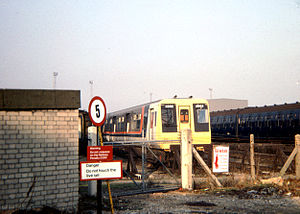This article needs additional citations for verification. (December 2009) |
| British Rail Class 445 and 446 | |
|---|---|
 4PEP unit No.4002 in the sidings at Wimbledon depot | |
| In service | 1971-1980 |
| Manufacturer | BREL |
| Order no. |
|
| Built at | BREL York |
| Family name | 1972 design (PEP)[2] |
| Constructed | 1971 |
| Entered service | 1973[1] |
| Number built |
|
| Number scrapped | All |
| Formation | 2/4 cars per trainset:
|
| Diagram |
|
| Design code |
|
| Fleet numbers |
|
| Capacity |
|
| Operators | British Rail |
| Specifications | |
| Train length |
|
| Car length |
|
| Width | 9 ft 3 in (2.82 m)[1] |
| Height | 11 ft 6+1⁄2 in (3.518 m) |
| Doors | Bi-parting sliding |
| Maximum speed | 75 mph (121 km/h) |
| Weight |
|
| Traction motors | 4 × GEC[1] (per car) |
| Power output | 4 x 100 hp (75 kW) (per car)
|
| Electric system(s) | 750 V DC third rail |
| Current collector(s) | Contact shoe |
| Bogies | |
| Braking system(s) |
|
| Coupling system |
|
| Multiple working | Within type only |
| Track gauge | 1,435 mm (4 ft 8+1⁄2 in) standard gauge |
The PEP (Prototype Electro Pneumatic Train) Stock were prototype electric multiple units used on British Rail's Southern and Scottish Regions during the 1970s and early 1980s. They were forerunners of the British Rail Second Generation electric multiple unit fleet. Three units were built, one two-car unit (2001), and two four-car units (4001/4002). Under TOPS, the driving cars were originally classified as Class 461 with the non-driving motor cars as Class 462.[1] They were later reclassified as Class 445 (4PEP) and Class 446 (2PEP).
Internal layout was for commuter services; low-backed, bus-style 2+2 seating in open saloons, wide gangways with hanging straps, and no lavatory facilities. They were the first electric multiple units designed by British Rail with electric sliding doors,[4] outside the Scottish Region. They were unable to operate with any other stock due to their new coupling system.[5] Externally, 2001 was finished in unpainted aluminium, while 4001/4002 were painted in all-over Rail Blue.[6] In passenger use, they normally operated together as a ten-car formation.
- ^ a b c d e f g h i j Longworth 2015, pp. 40, 45, 142, 144
- ^ "PROTOTYPE ELECTRO PNEUMATIC TRAIN: HC Deb 23 October 1973 vol 861 cc1217-24". Parliamentary Debates (Hansard). 23 October 1973. Retrieved 21 February 2016.
- ^ Bull, J. T.; Cronin, J. E. (1978). "Introducing GN Electrics". Proceedings of the Institution of Mechanical Engineers. 192 (1): 72. doi:10.1243/PIME_PROC_1978_192_008_02. ISSN 0020-3483.
- ^ "High Density PEP stock on Southern Region". Testing Times. Archived from the original on 12 March 2016. Retrieved 21 February 2016.
- ^ "2-Pep and 4-Pep". Southern Railway E-mail Group. Retrieved 21 February 2016.
- ^ "PEP: The commuter train of the future". Testing Times. Archived from the original on 20 December 2016. Retrieved 21 February 2016.